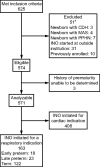Inhaled Nitric Oxide Use and Outcomes in Critically Ill Children With a History of Prematurity
- PMID: 34552014
- PMCID: PMC8810581
- DOI: 10.4187/respcare.08766
Inhaled Nitric Oxide Use and Outcomes in Critically Ill Children With a History of Prematurity
Abstract
Background: Inhaled nitric oxide (INO) is used to treat hypoxic respiratory failure without clear evidence of benefit. Future trials to evaluate its use will be designed based on an understanding of the populations in which this therapy is provided and with outcomes based on patient characteristics, for example, a history of premature birth.
Methods: This was a multi-center prospective observational study that evaluated subjects in the pediatric ICU who were treated with INO for a respiratory indication, excluding those treated in the neonatal ICU or treated for birth-related disease. We used logistic regression to evaluate characteristics associated with mortality and duration of mechanical ventilation. Specifically, we compared subjects born early preterm (<32 weeks post-conceptual age), late preterm (32-37 weeks post-conceptual age), and full term.
Results: A total of 163 children (median age [interquartile range], 1.8 [0.7-6.0] y) were included, 41 (25.2%) had a history of preterm birth (18 born early preterm and 23 born late preterm). INO was initiated for less-severe lung disease in the early preterm versus late preterm versus full-term subjects (median mean airway pressures, 16 vs 19 vs 19 cm H2O; P = .03), although the oxygenation index and oxygenation saturation index did not differ. The early preterm subjects had more ventilator-free days (median, 18.0, 7.0, 4.5 d; P = .02) and lower 28-d mortality (0, 26.1, 32.0%; P = .007). Lower respiratory tract disease, but not a history of prematurity, was independently associated with lower mortality.
Conclusions: INO was used differently in early preterm subjects. Clinical trials that evaluate INO use should have standardized oxygenation deficit thresholds for initiation of therapy and should consider stratifying by early preterm status.
Keywords: Acute Respiratory Distress Syndrome; critical care outcomes; infant; nitric oxide; pediatric; premature; pulmonary hypertension; right ventricular failure.
Copyright © 2021 by Daedalus Enterprises.
Figures


Similar articles
-
The early use of inhaled nitric oxide in premature infants requiring respiratory support.Ann Med. 2023;55(2):2266633. doi: 10.1080/07853890.2023.2266633. Epub 2023 Dec 11. Ann Med. 2023. PMID: 38079494 Free PMC article. Review.
-
Inhaled nitric oxide in term/late preterm neonates with hypoxic respiratory failure: estimating the financial impact of earlier use.J Med Econ. 2015;18(8):612-8. doi: 10.3111/13696998.2015.1038270. Epub 2015 May 7. J Med Econ. 2015. PMID: 25853867
-
Inhaled nitric oxide for respiratory failure in preterm infants.Neonatology. 2012;102(4):251-3. doi: 10.1159/000338552. Epub 2012 Aug 15. Neonatology. 2012. PMID: 22907671 Review.
-
Early Use of Inhaled Nitric Oxide in Preterm Infants: Is there a Rationale for Selective Approach?Am J Perinatol. 2017 Apr;34(5):428-440. doi: 10.1055/s-0036-1592346. Epub 2016 Sep 14. Am J Perinatol. 2017. PMID: 27627792 Free PMC article.
-
Acute and sustained effects of early administration of inhaled nitric oxide to children with acute respiratory distress syndrome.Pediatr Crit Care Med. 2004 Sep;5(5):469-74. doi: 10.1097/01.pcc.0000137986.83738.d7. Pediatr Crit Care Med. 2004. PMID: 15329164
References
-
- Bastek JA, Sammel MD, Paré E, Srinivas SK, Posencheg MA, Elovitz MA. Adverse neonatal outcomes: examining the risks between preterm, late preterm, and term infants. Am J Obstet Gynecol 2008;199(4):367.e1-e8. - PubMed
-
- Engle WA, Tomashek KM, Wallman C, Committee on Fetus and Newborn, American Academy of Pediatrics. “Late-preterm” infants: a population at risk. Pediatrics 2007;120(6):1390-1401. - PubMed
-
- Grégoire MC, Lefebvre F, Glorieux J. Health and developmental outcomes at 18 months in very preterm infants with bronchopulmonary dysplasia. Pediatrics 1998;101(5):856-860. - PubMed
Publication types
MeSH terms
Substances
Grants and funding
LinkOut - more resources
Full Text Sources
Medical

